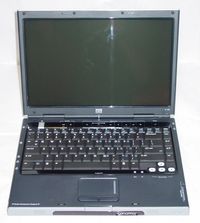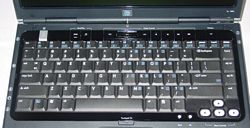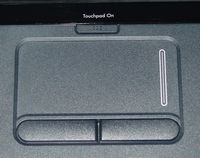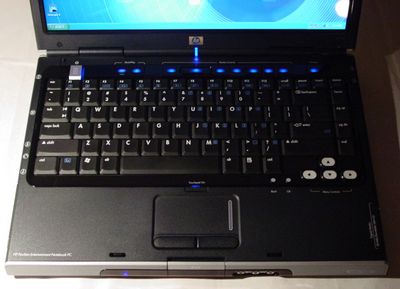HP Pavilion DV1000 Entertainment Notebook PC - Multimedia Notebook A Breed Apart
by Jason Clark on October 2, 2004 11:03 AM EST- Posted in
- Laptops
Construction - Build, Appearance, Size
Upon opening the notebook, we were surprised to be greeted with a nice and shiny display. This is very reminiscent of the coating that we saw on the Toshiba 5205 notebook".The display for this the HP Pavilion DV1000 Entertainment Notebook PC is also very similar to the one that we saw on the Acer Aspire 2020, on which the resolution is limited to lower than 1280 x 1024 (the Aspire 2020 is limited to a max of 1280 x 800). Since most of the wide-screen displays are of the 15.4" variety, we are used to resolutions like 1920 x 1200, or 1680 x 1050. But the main difference from the rest of the pack is the special coating that makes everything from text to images more brilliant and details more vibrant, particularly during multimedia use. HP apparently calls this BrightView. The coating itself seems to be a high gloss plastic film.
In our field tests, movies seemed to be able to show details to a finer degree than other notebooks that we were accustomed to. However, we should note that this 14.0" WXGA display is limited to 1280 x 768 (15:9 ratio), which means that if you plan to do even some light gaming, you will be limited to 1024 x 768 (unless you use the notebook's VGA out option). This is aside from the fact that it uses an Intel IGP solution, as opposed to something from NVIDIA or ATI.
And while HP calls their display a high-definition one, it is not HD in the way that we know HD from HDTV. Why they use this term is more likely a matter of marketing in reference to their BrightView technology.
The keyboard is just what we expect on a consumer notebook from HP: tactile with a reasonable degree of feedback. Compared to our Compaq Presario 1500T, it is fairly comparable. And in the whole scheme of laptop keyboards, it is probably average, noticeably shy of HP's business line and IBM's notebook keyboards. The function and control keys are appropriately placed, which is definitely a plus. The only thing we noticed was that some of the secondary functions require two hands, since the function key is on the lower left hand area of the keyboard, and there are secondary function buttons all along the top side of the keyboard.
The touchpad is just what we expect from a multimedia notebook: good feedback with a good texture. The touchpad buttons are smaller than what we are use to, but they have a large enough profile that it doesn't become something that annoys you, and they feel somewhat natural for the keyboard. Note that above the touchpad, there is a button that can enable/disable the touchpad, which solves the problem of the cursor "magically" appearing and interrupting your viewing when you are watching a DVD.
Perhaps one of the most aesthetically appealing design features of the DV1000 is the backlighting implementation for the various function buttons surrounding the keyboard. Lit in a neon blue hue scheme, it gives clarity and a marker for where specific keys are located. Keeping in mind that most people like a "theater" effect (i.e. a dark room) when they watch movie, we think that this was a nice addition to have. Often times, we found that in a flight, we had to turn our ThinkPad's display light to find the appropriate button. With other notebooks, it is often times a guess and check scenario. In this respect, LEDs are very beneficial. And the fact that the casing is a translucent black helps hide the LEDs when the system is off. (The backlit LEDs are only active when the system is on, which includes when the lid is closed.) However, we should note that we have not found a way to turn off the LEDs when the system is on.
The mute button and wireless button will only have their backlights active when the function is active.
The LEDs for the system are on the front of the system: power on (blue when active), hard drive activity (blue when active), and battery status (solid blue when charging, blinking blue when low). There is an additional wireless LED centered upon the display lid above the keyboard, which is blue when wireless radio is enabled. This LED is also visible when the display lid is closed.














10 Comments
View All Comments
Biochem101 - Thursday, October 28, 2004 - link
Ohh yeah, just to add.The dv1040us machine has at the minimum the following specs:
Centrino 725 1.6GHz CPU 2mb cache
64 mb shared video memory (cry, but im dealing with it)
Those are the only differnces that stand out from the AT review model.
Biochem101 - Thursday, October 28, 2004 - link
I just picked one of these puppies up for ~1100 AR. When I was shopping, I was looking for a very portable laptop with some performnce. So far I love it. The screen seems to have a built in anti-glare film similar to the film used on my Sony Trinitron CRT. It provides adequate glare relief in most situations. I did notice the font blur and was somewhat dissappointed with that problem. But all in all, I found a compact, light and relatively powerful laptop with great battery performance. I havent done any performance tests on the machine yet (its the 1.6G version - dv1040us model), but I doubt there will be much difference between my machine and he one AT has reviewed here.imho- im glad a ran across this review, I was just looking for some info on the general performance of the chipset in the machine, not a machine specific review. KUDOS to AT for souping up their number of reviews.
Pete - Sunday, October 24, 2004 - link
BTW, the glare on this laptop was pretty harsh when I viewed it in CompUSA, although there was a very bright fluorescent light directly behind my shoulder. My eyes got tired looking at it after 15 mins, whereas the "regular" LCD on the Toshiba next to it was *very* easy to read.It's not just that the dv1000's screen was glossy, either. Cleartype fonts looked kind of blurry or oily, not nice at all. Actually, it's possible the screen was something like BGR, and Cleartype was set for RGB subpixel smoothing. I'll have to look into that, as the screen is this laptop's Achilles heel, and one too big for me to ignore.
Pete - Sunday, October 24, 2004 - link
No, but a faster video card will, and the BenQ Joybook 7000 has the same formfactor and screen with a Mobility Radeon 9700 to boot! I'm convinced that would sell like hotcakes here, and I'm not sure why either HP or BenQ haven't started selling them here. Apparently this Intel IGP scores 2.5K in 3DM2001, not even 2003--frickin' abysmal. I'm not even sure it'd be fast enough for something like Age of Mythology or Warcraft 3 at this screen's native res.Andrew, start pushing Anandtech's weight around to get a laptop with this formfactor and discrete graphics in the USA! :)
airfoil - Thursday, October 7, 2004 - link
Quote: "but for another $100 or $150, you can configure your DV1000 with a 1.7GHz Pentium-M 735 or 1.8GHz Pentium-M 745, respectfully."Respectfully? Does a faster prcoessor buy more respect?
trikster2 - Monday, October 4, 2004 - link
#3 that's really strange. 2gb just to play a DVD sounds excessive#4 Not sure who the ODM is but there is a Benq Joybean that is identicle
#3 my main reservation with this notebook is the brightview or whatever screen. The ones I've seen on sony and fujitsu's at frys have a lot of glare. I dumped my CRT for an LCD due to glare (lots of windows) would hate to be fighting glare on a glossy laptop screen too.
In comparison to a CRT, how bad is the glare on this laptop?
Thanks!
SDA - Sunday, October 3, 2004 - link
Question-- who makes this notebook? (I know it has an HP sticker, but IIRC HP don't make their own notebooks like.) I ask because I'd like to see if there are any nearly identical no-name equivalents available.AndrewKu - Saturday, October 2, 2004 - link
#2 - Windows is reading it wrong.Scarceas - Saturday, October 2, 2004 - link
The article says a 2GB partition is used for the quickplay system.The screen shot shows 204MB. 204MB seems more reasonable. Might want to update that.
CasmirRadon - Saturday, October 2, 2004 - link
Sounds great, if/when my old Presario notebook craps out on me in the next year or so this will be the kind of form-factor/functionality that I will be looking for. My friend just got a Pavillion, and I must say that it makes me jealous if only for the exceedingly convenient placement of headphone/usb ports. That is the kind of feature that many of us forget to look for when shopping for a notebook, but makes all the difference after extended use.